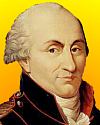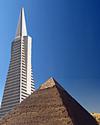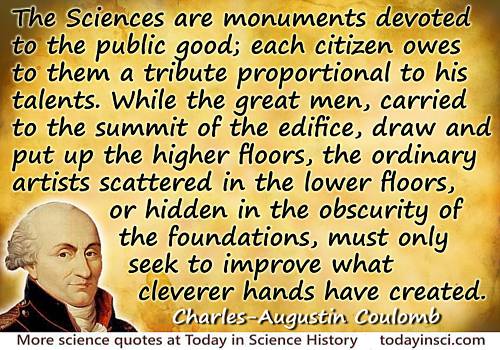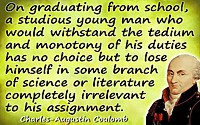 (source)
(source)
|
Charles-Augustin Coulomb
(14 Jun 1736 - 23 Aug 1806)
French physicist who was a civil engineer in his early career, and later conducted experiments on electricity, for which he is best known. The SI unit of charge was named for him.
|
Charles-Augustin Coulomb
“The Sciences are monuments”
Illustrated Quote - Medium (500 x 350 px)

More Charles-Augustin de Coulomb quotes on science >>
This quote was written early in Coulomb's career, when he was a civil engineer. Hence the metaphor of a building is very apt. Charles-Augustin Coulomb is now remembered for his pioneering researches on electricity (for which the SI unit of charge has been named after him) that he undertook later in life. However, as a young graduate of the École du Corps Royale du Génie, he was qualified to act as the engineering officer assigned to Martinique (Feb 1764 to Jun 1772).
During the eight years he spent at Martinique, his duties included designing defensive fortifications on the island to protect it against possible attacks by the English Navy. For the construction designs, he had to work on the four “classic” eighteenth-century problems of civil engineering: the strength of columns and beams, the thrust of soil, and the thrust of arches. He wrote a book-length Mémoire1 of his solutions to these problems, which he read to the Académie Royale des Sciences on 10 Mar 1773 and 2 Apr 1773, the year after he had returned to France. It was published in 1776.
The most notable section of this book deals with the mathematical analysis of the problem of the thrust of soil. This was such a fundamental advance over any previous effort by others, that he is regarded as the father of soil mechanics.
Although originally written for his own use, as he developed the mathematical treatments applied to civil engineering, he published his work in the hope that it would be useful to others. He expressed this in his Introduction,1 addressed to the Académie: “Les Sciences sont des monumens consacrés au bien public; chaque citoyen leur doit un tribut proportionné à sès talens. Tandis que les grands hommes, portés au sommet de l’édifice, tracent & élèvent les étages supérieurs, les artistes ordinaires répandus dans les étages inférieurs, ou cachés dans l’obscurité des fondemens, doivent seulement chercher à perfectionner ce que des mains plus habiles ont créé.”
“The Sciences are monuments devoted to the public good; each citizen owes to them a tribute proportional to his talents. While the great men, carried to the summit of the edifice, draw and put up the higher floors, the ordinary artists scattered in the lower floors, or hidden in the obscurity of the foundations, must only seek to improve what cleverer hands have created.”
In his book on Structural Analysis,2 Jacques Heyman restates this part of Coulomb’s introduction..Quoting in Heyman’s words, Coulomb hoped that “the Académie will find his small contribution to the monument of learning to be useful; the grand design is in the hands of great men, but lesser workers, hidden in the darkness of the foundations, may also perhaps be of help.”
2 Jacques Heyman, Structural Analysis: A Historical Approach (1998), 24.
- Science Quotes by Charles-Augustin Coulomb.
- 14 Jun - short biography, births, deaths and events on date of Coulomb's birth.
- Charles Augustin de Coulomb - Biography 1890)
- Charles-Augustin Coulomb - context of quote “The sciences are monuments” - Large image (800 x 600 px)
- Charles-Augustin Coulomb - context of quote “Withstand the tedium and monotony of his duties” - Medium image (500 x 350 px)
- Charles-Augustin Coulomb - context of quote “Withstand the tedium and monotony of his duties” - Large image (800 x 600 px)
- Coulomb and the Evolution of Physics and Engineering in Eighteenth Century France, by C. Stewart Gilmor. - book suggestion.






